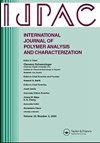Investigation of the structural variations of cellulose microcrystals obtained after acid hydrolysis of waste cotton: a statistical approach
IF 1.7
4区 工程技术
Q4 POLYMER SCIENCE
International Journal of Polymer Analysis and Characterization
Pub Date : 2023-07-04
DOI:10.1080/1023666X.2023.2247252
引用次数: 0
Abstract
Abstract The intricate and complex network of inter- and intramolecular hydrogen bonds in cellulose exerts a significant influence on the overall crystallographic structure of the cellulose polymer. Hence, understanding the hydrogen bonding interactions during cellulose hydrolysis is vital for tailoring the degree of crystallinity of cellulose-based materials like cellulose microcrystals (CMCs). In this study, we used a Box–Behnken statistical tool to optimize the experimental parameters for synthesizing CMCs with a high total crystallinity index (TCI). We then used field emission scanning electron microscopy, X-ray photoelectron spectrometry, X-ray diffraction, and Fourier transform infrared spectroscopy to investigate the morphological, chemical, crystalline, and structural changes that occurred in the CMC sample with the highest TCI. Our results showed that the hydrolysis process modified the hydrogen bonding network in cellulose, which resulted in an enhanced TCI. The changes in hydrogen bonding significantly affected CH bending and stretching absorption, resulting in an increased TCI of the cellulose samples. This increased TCI plays a significant role in enhancing the reinforcing properties of CMCs. Our findings highlight new insights into the role of hydrogen bonding in the TCI of CMCs and could lead to the development of new methods for controlling the TCI of cellulose. Highlights of the article Optimization of the acid hydrolysis process of waste cotton using Box–Behnken design to obtain cellulose microcrystals (CMCs). Extraction of the mathematical model that influences the total crystallinity index of CMCs. Investigation of morphological, chemical, crystalline, and structural changes in CMCs. Comparison of hydrogen bonding network between waste cotton fibers and CMCs. Increased TCI enhances CMCs’ reinforcing properties in composites.废棉酸水解后纤维素微晶结构变化的研究:统计学方法
纤维素分子间和分子内的氢键网络错综复杂,对纤维素聚合物的整体晶体结构有重要影响。因此,了解纤维素水解过程中的氢键相互作用对于调整纤维素基材料(如纤维素微晶(cmc))的结晶度至关重要。在本研究中,我们使用Box-Behnken统计工具来优化合成具有高总结晶度指数(TCI)的cmc的实验参数。然后,我们使用场发射扫描电镜,x射线光电子能谱,x射线衍射和傅里叶变换红外光谱来研究在TCI最高的CMC样品中发生的形态,化学,晶体和结构变化。我们的研究结果表明,水解过程改变了纤维素中的氢键网络,从而提高了TCI。氢键的变化显著影响CH弯曲和拉伸吸收,导致纤维素样品的TCI增加。这种增加的TCI在增强cmc的增强性能方面起着重要作用。我们的发现突出了氢键在cmc的TCI中的作用的新见解,并可能导致控制纤维素TCI的新方法的发展。利用Box-Behnken设计优化废棉酸水解工艺,获得纤维素微晶(cmc)。影响cmc总结晶度指数的数学模型的提取。cmc的形态、化学、晶体和结构变化的研究。废棉纤维与cmc之间氢键网络的比较。TCI的增加提高了复合材料中cmc的增强性能。
本文章由计算机程序翻译,如有差异,请以英文原文为准。
求助全文
约1分钟内获得全文
求助全文
来源期刊
CiteScore
3.50
自引率
5.30%
发文量
37
审稿时长
1.6 months
期刊介绍:
The scope of the journal is to publish original contributions and reviews on studies, methodologies, instrumentation, and applications involving the analysis and characterization of polymers and polymeric-based materials, including synthetic polymers, blends, composites, fibers, coatings, supramolecular structures, polysaccharides, and biopolymers. The Journal will accept papers and review articles on the following topics and research areas involving fundamental and applied studies of polymer analysis and characterization:
Characterization and analysis of new and existing polymers and polymeric-based materials.
Design and evaluation of analytical instrumentation and physical testing equipment.
Determination of molecular weight, size, conformation, branching, cross-linking, chemical structure, and sequence distribution.
Using separation, spectroscopic, and scattering techniques.
Surface characterization of polymeric materials.
Measurement of solution and bulk properties and behavior of polymers.
Studies involving structure-property-processing relationships, and polymer aging.
Analysis of oligomeric materials.
Analysis of polymer additives and decomposition products.

 求助内容:
求助内容: 应助结果提醒方式:
应助结果提醒方式:


